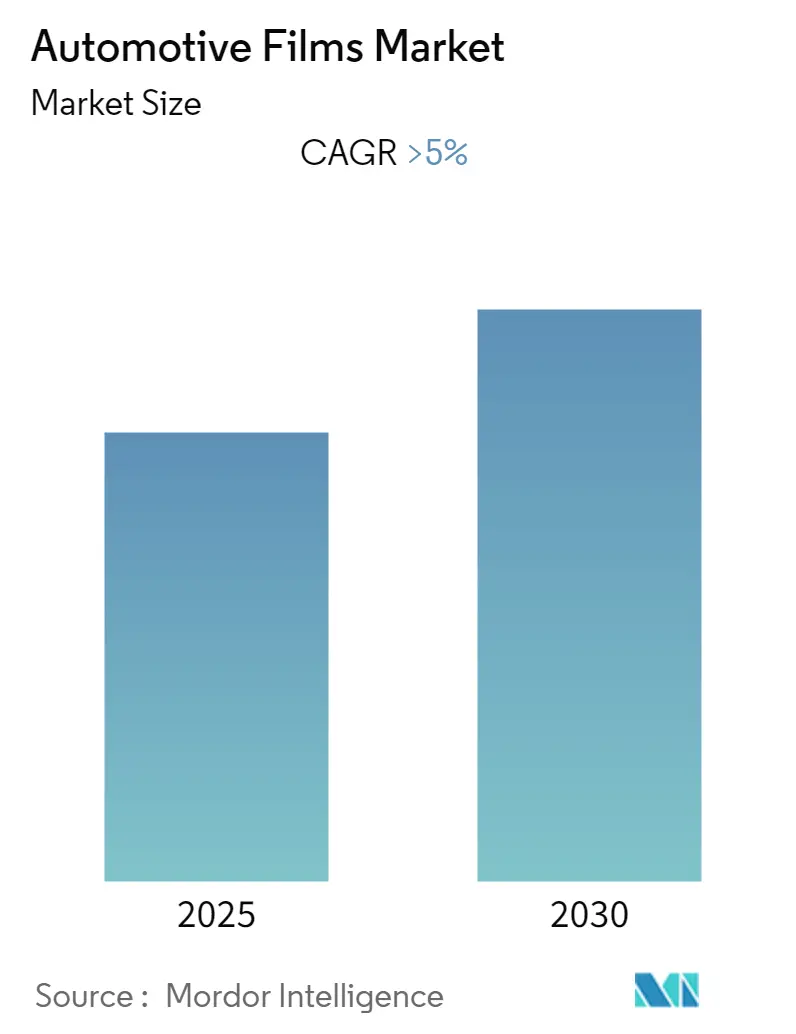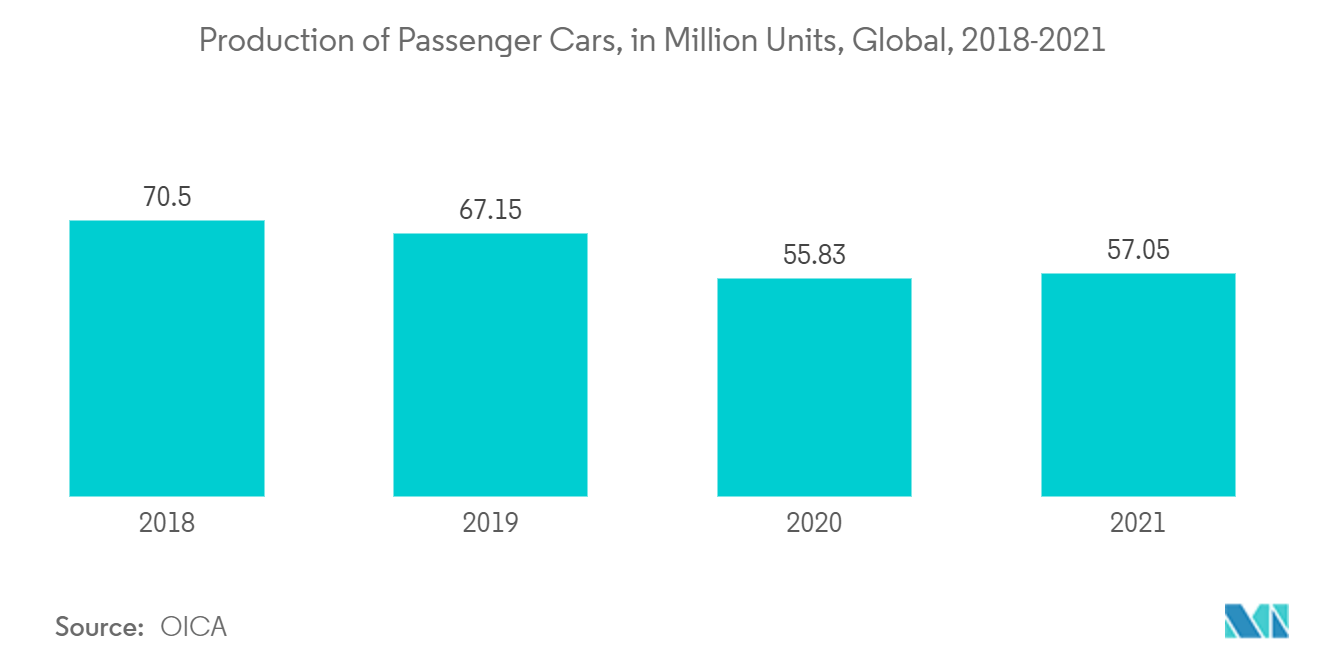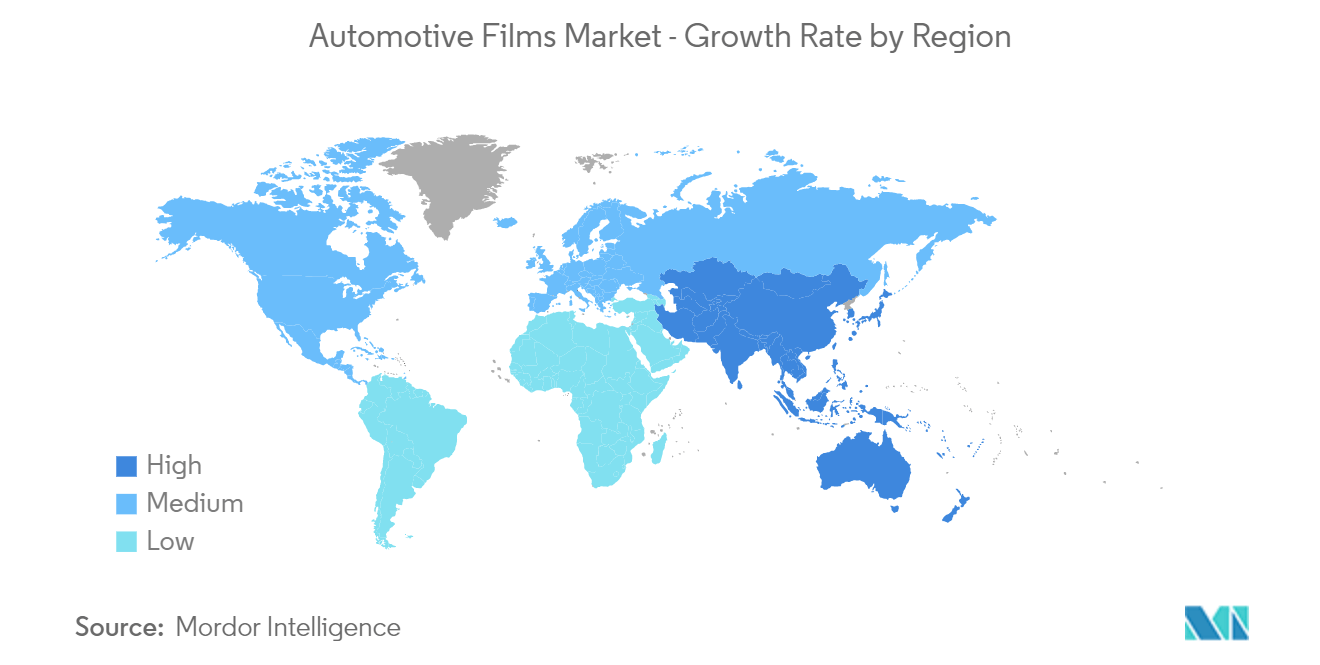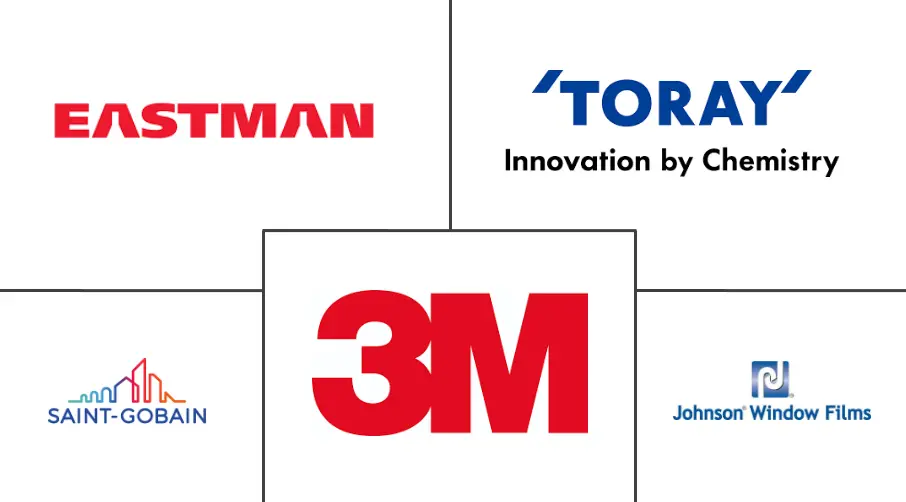Automotive Films Market Size and Share

Automotive Films Market Analysis by Mordor Intelligence
The Automotive Films Market is expected to register a CAGR of greater than 5% during the forecast period.
In 2020, COVID-19 had a detrimental effect on the market.Considering the pandemic scenario, the automotive manufacturing units were on a temporary halt during the government-imposed lockdown to curb the spread of COVID-19 cases. However, increased automotive production after the pandemic propelled the demand for automotive films.
- In the short term, the market is likely to grow because of rising concerns about safety, security, and privacy, as well as rising demand for automotive films in Asia-Pacific and Europe.
- On the flip side, the occurrence of technical issues with dyed and metalized films, which result in low heat reduction and GPS transmission interference, is likely to hinder the market's growth.
- The market is expected to have a chance in the future because of the growing demand for electric vehicles and new laws in places like the United States that require the use of automotive films.
- Asia-Pacific dominated the global market share. With significant automotive production and sales in countries such as China, India, Indonesia, Thailand, and Japan, the usage of automotive films is increasing throughout the region.
Global Automotive Films Market Trends and Insights
Increasing Demand from the Passenger Vehicles Segment
- Passenger cars provide the dominant mode of road transport in much of the world. About 70 million new cars are produced each year, with nearly all being fueled by petrol (gasoline) or diesel. They account for about 45% of the global energy used in transport, which itself accounts for about 20% of primary energy consumption.
- Window films are laminated either on the exterior or interior of the glass windows in passenger vehicles, which provides protection as well as sustainability to the vehicles. They are installed to reduce the excessive heat transmitted to vehicles.
- Window films provide an extra level of protection against the harmful infrared and ultraviolet rays coming from the sun. Additionally, window tints reduce the workload on the vehicle's air conditioning system.
- Additionally, it provides increased privacy, a faded interior, less glare, and provides security for valuables inside the car. Additionally, it increases the vehicle's overall appearance, and hence, it finds application in passenger vehicles, mostly in windows.
- The production of passenger cars has increased globally since the pandemic began. In 2021, the global production of passenger cars was around 57.05 million units, up from 55.83 million units the previous year, according to OICA.
- As per the China Passenger Car Association (CPCA), sales in February 2023 were around 1.42 million units, 10.4% higher than a year earlier. Additionally, sales of new energy vehicles (NEVs), which include pure battery electric cars and plug-in hybrids, grew faster than the overall market, up 61% in February from a year earlier.
- The India passenger car market was valued at USD 32.70 billion in 2021, and it is expected to reach a value of USD 54.84 billion by 2027, while registering a CAGR of over 9% between 2022 and 2027, according to the India Brand Equity Foundation (IBEF).
- Therefore, the aforementioned factors are expected to have a significant impact on the Automotive Films Market in the coming years.

The Asia-Pacific Region to Dominate the Market
- The Asia-Pacific region dominated the global market share. With automotive production and sales growth in countries such as China, India, Indonesia, Thailand, and Japan, the usage of automotive films is increasing throughout the Asia-Pacific region.
- According to OICA, China is the largest producer and consumer of automotive vehicles. In April 2022, approximately 965 thousand units of passenger cars and 216 thousand units of commercial vehicles were sold in China.
- India is also one of the biggest markets in the Asia-Pacific area for automotive films.According to OICA, around 4.4 million vehicles were produced in India during 2021, compared to 3.39 million vehicles that were produced in 2020, witnessing an increasing growth rate of about 30%.
- By volume, India is expected to be the third largest market for cars in the world by 2026, which is good news for electric and commercial vehicles.The rise in demand is attributable to an increase in average household income to become the youngest nation by 2025, increasing vehicle penetration, and expanding the research and development hubs.
- The Government of India aims to develop India as a global manufacturing center. Reforms such as the GST may boost industry growth. Under the new GST regime, the GST on electric vehicles has been reduced from 12% to 5%. The electric vehicle market is estimated to reach INR 50,000 crore (USD 7.09 billion) in India by 2025. A study by the CEEW Center for Energy Finance recognized a USD 206 billion opportunity for electric vehicles in India by 2030.
- According to OICA, Japan is the second-largest vehicle producer in the Asia-Pacific region. Around 7.85 million vehicles were produced in Japan in 2021, compared to 8.06 million vehicles that were produced in 2020, witnessing a decreasing growth rate of about 3%.
- Therefore, the aforementioned factors are expected to have a significant impact on the Automotive Films Market in the coming years.

Competitive Landscape
The Automotive Films Market is partially consolidated in nature. Some key players in the automotive films market include Saint-Gobain, TORAY INDUSTRIES INC., 3M, Eastman Chemical Company, and Johnson Window Films Inc., among others (not in any particular order).
Automotive Films Industry Leaders
-
Saint-Gobain
-
Eastman Chemical Company
-
3M
-
TORAY INDUSTRIES, INC.
-
Johnson Window Films, Inc.
- *Disclaimer: Major Players sorted in no particular order

Recent Industry Developments
- February 2023: Eastman Chemical Company acquired Ai-Red Technology (Dalian) Co., Ltd., a manufacturer and supplier of paint protection and window film for auto and architectural markets in the Asia Pacific region. This acquisition demonstrates Eastman's commitment to driving growth in Performance Films and the paint protection and window film markets.
- December 2022: Toray Industries, Inc., developed a polyethylene terephthalate (PET) film that combines excellent applicability and adhesion for water-based and solvent-free coatings and can eliminate solvent-derived carbon-dioxide emissions. The company looks to produce the film at a domestic plant by end-March 2024 to help popularize eco-friendly film products for which decarbonization during manufacturing is desirable. These items include release, adhesive, printing, packaging, and automotive films.
Global Automotive Films Market Report Scope
The automotive film is a thin laminate that is used on the inside and outside of a car. It gives the driver and passengers more security and privacy. Automotive can be made up of different materials, including polycarbonate, polyester, polystyrene, polyvinyl chloride, and others. These films improve the overall appearance of the vehicle and can also be used to block solar ultraviolet radiation and provide comfort by reducing glare from the sun.
The Automotive Films Market is segmented by film type, vehicle type, and geography. By film type, the market is segmented into window films, automotive paint protection films, and automotive wrapping films. By vehicle type, the market is segmented into passenger vehicles and commercial vehicles. The report also covers the market size and forecasts for the automotive film market in 15 countries across major regions. For each segment, the market sizing and forecast have been done on the basis of revenue (USD million).
| Window Films/Tints | Dyed Window Tint |
| Metallized Window Tint | |
| Ceramic Window Tint | |
| Carbon Window Tint | |
| Other Window Films/ Tints (Hybrid, Crystalline, etc.) | |
| Automotive Paint Protection Films | |
| Automotive Wrapping Films |
| Passenger Vehicles |
| Commercial Vehicles |
| Asia-Pacific | China |
| India | |
| Japan | |
| South Korea | |
| Rest of Asia-Pacific | |
| North America | United States |
| Canada | |
| Mexico | |
| Europe | Germany |
| United Kingdom | |
| Italy | |
| France | |
| Rest of Europe | |
| South America | Brazil |
| Argentina | |
| Rest of South America | |
| Middle-East and Africa | Saudi Arabia |
| South Africa | |
| Rest of Middle East and Africa |
| Film Type | Window Films/Tints | Dyed Window Tint |
| Metallized Window Tint | ||
| Ceramic Window Tint | ||
| Carbon Window Tint | ||
| Other Window Films/ Tints (Hybrid, Crystalline, etc.) | ||
| Automotive Paint Protection Films | ||
| Automotive Wrapping Films | ||
| Vehicle Type | Passenger Vehicles | |
| Commercial Vehicles | ||
| Geography | Asia-Pacific | China |
| India | ||
| Japan | ||
| South Korea | ||
| Rest of Asia-Pacific | ||
| North America | United States | |
| Canada | ||
| Mexico | ||
| Europe | Germany | |
| United Kingdom | ||
| Italy | ||
| France | ||
| Rest of Europe | ||
| South America | Brazil | |
| Argentina | ||
| Rest of South America | ||
| Middle-East and Africa | Saudi Arabia | |
| South Africa | ||
| Rest of Middle East and Africa | ||
Key Questions Answered in the Report
What is the current Automotive Films Market size?
The Automotive Films Market is projected to register a CAGR of greater than 5% during the forecast period (2025-2030)
Who are the key players in Automotive Films Market?
Saint-Gobain, Eastman Chemical Company, 3M, TORAY INDUSTRIES, INC. and Johnson Window Films, Inc. are the major companies operating in the Automotive Films Market.
Which is the fastest growing region in Automotive Films Market?
Asia-Pacific is estimated to grow at the highest CAGR over the forecast period (2025-2030).
Which region has the biggest share in Automotive Films Market?
In 2025, the Asia-Pacific accounts for the largest market share in Automotive Films Market.
What years does this Automotive Films Market cover?
The report covers the Automotive Films Market historical market size for years: 2019, 2020, 2021, 2022, 2023 and 2024. The report also forecasts the Automotive Films Market size for years: 2025, 2026, 2027, 2028, 2029 and 2030.
Page last updated on:



